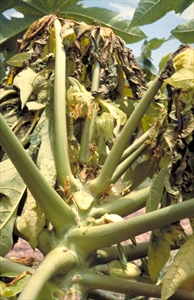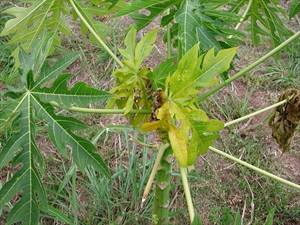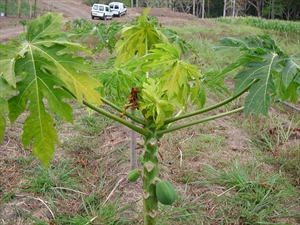There are several strains of phytoplasma involved in these diseases and they have a number of names, e.g., papaya dieback disease, yellow mottle, mosaic and papaya bunchy top.
Pacific Pests, Pathogens and Weeds - Online edition
Pacific Pests, Pathogens & Weeds
Papaya phytoplasmas (174)
The severe papaya dieback disease, which occurs in Australia, is known as Candidatus Phytoplasma australiense. This disease is related to or the same as Australian grapevine yellows and Phomium yellow leaf (Phomium is known as New Zealand flax). A disease on papaya with similar symptoms occurs in New Caledonia1. It is not known if this is caused by Candidatus Phytoplasma australiense. However, this phytoplasma is recorded from New Caledonia, in strawberry.
Phytoplasma diseases of papaya are reported from Australia, Cuba and other parts of the Caribbean, Ethiopia, Hawaii, India, Israel, Oman, and South Africa. Possibly, a phytoplasma disease of papaya exists in South and Central America. The diseases differ in a diagnostic region of ribosomal DNA. A disease with phytoplasma-like symptoms occurs in New Caledonia (see above).
Papaya. Weeds are likely hosts.
Molecular analyses have shown that yellow crinkle and mosaic are identical, and closely related to tomato big bud disease, but differ from papaya dieback disease. The phytoplasma that causes papaya dieback disease exists at low concentration in plants, but death of the apical shoot occurs within 2 weeks of visible symptoms, and 3 weeks after detection by molecular analyses.
There are a number of phytoplasma diseases of papaya:
Symptoms of papaya dieback disease (Australia and possibly New Caledonia) begin with the inner crown leaves showing a bunched appearance, yellowing, followed by a slight bending of the stem tip. One or more of these leaves shrivel and die, and a brown spot occurs where the leaf stalks join the stem. The larger leaves rapidly turn yellow, then die. The entire crown dies within 1-4 weeks. Any fruit which is present either falls off while still green or rots.
Symptoms of yellow crinkle disease (Australia) are a yellowing of leaves about halfway up the canopy, and a bending down of the petioles. The crown leaves develop clear patches at the margins and between the veins, and these areas become brown and die, and the leaves become tattered as they expand. Eventually the older leaves die and fall leaving a bare stem with a few stunted leaves on top. The flowers may show abnormal distortions.
Symptoms of mosaic (Australia) are stunted yellow leaves with clear margins and short stems with many side shoots. The petioles and upper stems have 'water-soaked' streaks - as if injected with water. The fruits may show light green areas. It is often difficult to distinguish symptoms of yellow crinkle from mosaic.
Symptoms of bunchy top (Caribbean) begin with faint yellow spotting (termed mottling) of the upper leaves, and then the leaves begin to die, especially at the margins and between the veins (compare to yellow crinkle above). Growth of leaves slows and the distance between them along the stem becomes shorter giving a 'bunchy top' appearance. The oldest leaves then fall down, leaving a few stunted leaves at the top of the stem. The plants may die, or new shoots appear from lower down the stem.
It is not certain which of these diseases exist in New Caledonia, but the bunching of the young yellow leaves and the bending of shoots were common symptoms of the trees at Moindou (Photos 1-5); this is similar to papaya dieback disease.
It is assumed that leafhoppers transmit these phytoplasma diseases. Orosius argentatus has been suggested as the carrier of yellow crinkle in Australia and Empoasca species in the Caribbean, but little is known of the biology of these leafhoppers. In Australia, major epidemics of papaya dieback occur when dry late winters and early springs favour insects spreading from outside vegetation to papaya plantations. Periodic epidemics of yellow crinkle also occur, especially after periods of hot, dry weather which favours the breeding of Orosius argentatus.
In Australia, papaya dieback is an economically important disease, more so than those diseases known as yellow crinkle and mosaic. The disease limits papaya production in southern and central Queensland, with outbreaks frequently causing losses of 10 to 100%.
The phytoplasma associated with papaya yellow crinkle disease has been transmitted using dodder (Cuscuta sp.), a parasitic plant, to tomato and some other test plants.
Look for yellowing and bunching of the young leaves, which later dry, die and fall off, bending of petioles and terminal shoots, and in the case of papaya dieback, rapid death after the first appearance of symptoms.
Molecular tests are needed to distinguish between these diseases. The tests are done on a ribosomal gene (16S rRNA). The ribosome is present in all cells and is the part where proteins are assembled.
CULTURAL CONTROL
Before planting:
- For yellow crinkle only: Plant at higher than normal density so that removal of disease trees will still maintain production levels.
During growth:
- For yellow crinkle only: Remove sources of the disease. Take infected trees out of the plantation and burn them.
- For papaya dieback only: Ratoon plants by cutting them 75 cm above ground level. This results in healthy regrowth of shoots. However, the plants may become reinfected.
- Maintain high level of weed control, as weeds are likely to harbour the phytoplasma pathogens involved in these diseases.
RESISTANT VARIETIES
Varieties differ in susceptibility to papaya dieback disease, and should be used as the only practical method of controlling it. However, tolerance to the disease varies from place to place, and this might be due to insect behaviour as much as the tolerance of varieties.
CHEMICAL CONTROL
Apply a systemic insecticides to kill the insects that spread the phytoplasma. Chemical control should be combined with the rogueing treatments under Cultural Control.
____________________
When using a pesticide, always wear protective clothing and follow the instructions on the product label, such as dosage, timing of application, and pre-harvest interval. Recommendations will vary with the crop and system of cultivation. Expert advice on the most appropriate pesticide to use should always be sought from local agricultural authorities.
AUTHOR Grahame Jackson
1Identified on symptoms by Professor Rob Harding, Science, Environmental and Biological Sciences, QUT, Queensland, at Moindou village, New Caledonia, 2003. Information from Guthrie JN (1998) Epidemiology of Phytoplasma-Associated Papaya Diseases in Queensland, Australia. Plant Disease 82(10): 1107-1111. (https://apsjournals.apsnet.org/doi/pdf/10.1094/PDIS.1998.82.10.1107); and from CABI (2020) Candidatus phytoplasma australiense. Invasive Species Compendium. (https://www.cabi.org/isc/datasheet/39956). Photo 1 Kohler F, et al. (1997) Diseases of cultivated crops in Pacific Island countries. South Pacific Commission. Pirie Printers Pty Limited, Canberra, Australia. Information from Diseases of fruit crops in Australia (2009). Editors, Tony Cooke, et al. CSIRO Publishing.
Produced with support from the Australian Centre for International Agricultural Research under project PC/2010/090: Strengthening integrated crop management research in the Pacific Islands in support of sustainable intensification of high-value crop production, implemented by the University of Queensland and the Secretariat of the Pacific Community.








